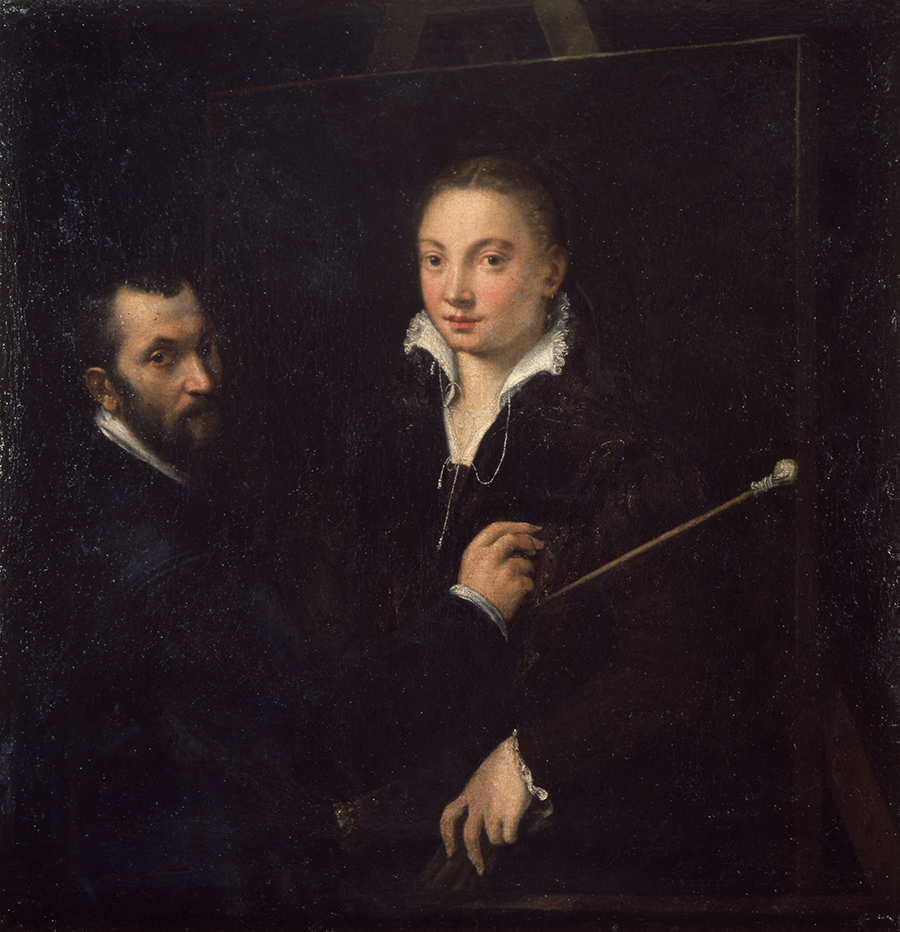A couple of weeks ago, I wrote about an incredible female artist called Lavinia Fontana. This week is all about the ‘tender and cruel’ Sofonisba Anguissola who made her name in Rome and later worked for Philip II Spain in Madrid.
Anguissola’s talent was recognised very early on, she was lucky enough to have a forward thinking and liberal father who was keen to educate his daughters (he had six in total and just one son) and he encouraged her to draw and paint and even got her a tutor, the artist Bernadino Campi.

Sofonisba Anguissola,
Self-portrait, 1560-1,
Pinacoteca Brera, Italy
That isn’t to say that life as a female artist was plain sailing for Anguissola. It is true that when she met Michelangelo in Rome in 1554 when she was in her early 20s he gave her sketches from his notebooks to help her develop her own style. There’s also evidence that he helped and guided her quite substantially over at least a couple of years. She must have really impressed him; Michelangelo was known to be massively grumpy and critical!
Around the same time that Anguissola met Michelangelo, the Florentine painter Francesco Salviati wrote a letter to her tutor, Campi, congratulating him on his great achievement. It went on to say that this achievement was born of his beautiful intellect. Was it that Anguissola was being educated and trained by the best of the best? Michelangelo and Campi?
Not so much.
Campi’s achievement was Anguissola!
The slight must have made Sofonisba at least a little bit peeved and we all know that revenge is a dish best served cold. Although there is no documentation that I’m aware of that lays out Anguissola’s intent, take a look at this double portrait.
It was described to me once as both incredibly tender and incredibly cruel.
It is an image of Bernadino Campi painting Sofonisba Anguissola’s portrait painted by Anguissola in 1559. Got it?! Anguissola has imitated his style in the painting of her portrait – the one that Campi is supposed to painting – but the thing is that he was a less accomplished artist than she was. So she is imitating his style, which should be flattering, but because he is the lesser artist, it isn’t. There’s another thing. She has also made herself the larger of the two so that she dominates him. Two fingers to Salviati? I think so. On the other hand, honouring Campi in her work in the first place was a lovely thing to do and the intimacy between them is, I feel, very apparent, especially when her original design is taken into account.

Sofonisba Anguissola, Bernardino Campi painting Sofonisba Anguissola, c.1559, Pinacoteca Nazionale, Siena
Take a look at these three images. The first is of the painting before it was restored in 1996. The second is during restoration and the third is post restoration.



In the the first and third image her left hand is holding a pair of gloves. During restoration, she appears to have grown a limb! A second left hand is visible reaching up as though to remove the brush or at least the mahlstick from Campi’s grasp. Or maybe she’s helping by holding the mahlstick steady as he paints the delicate lace of her dress?
You could say that this is a simple pentimento – a change that occurs as the artist works through their design on the canvas – but this version is very detailed so Anguissola got a long way down the line before she decided to let Campi get on with it and stopped trying to intervene / help, instead occupying her hand with the gloves.
It was decided to restore the painting to the image that Anguissola finally intended, hence the after restoration image doesn’t include the third arm.
Finally, I had to include this by painting by van Dyck of Anguissola in the last year of her life. It was painted in 1624, she died in 1625 aged 93.

Van Dyke, Sofonisba Anguissola, 1624, Knole House, Kent
The video of this episode can be viewed here. To view the entire ‘Elevenses with Lynne’ archive, head to the Free Art Videos page.




Recent Comments